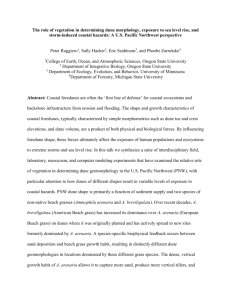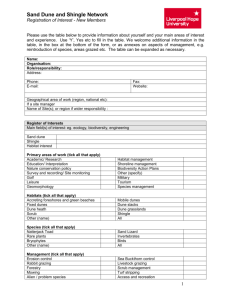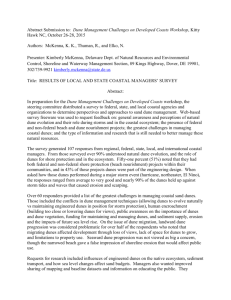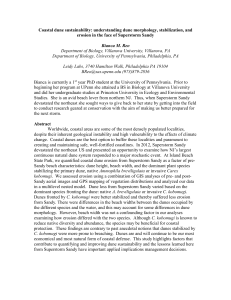management of sand dunes within the context of coastal
advertisement
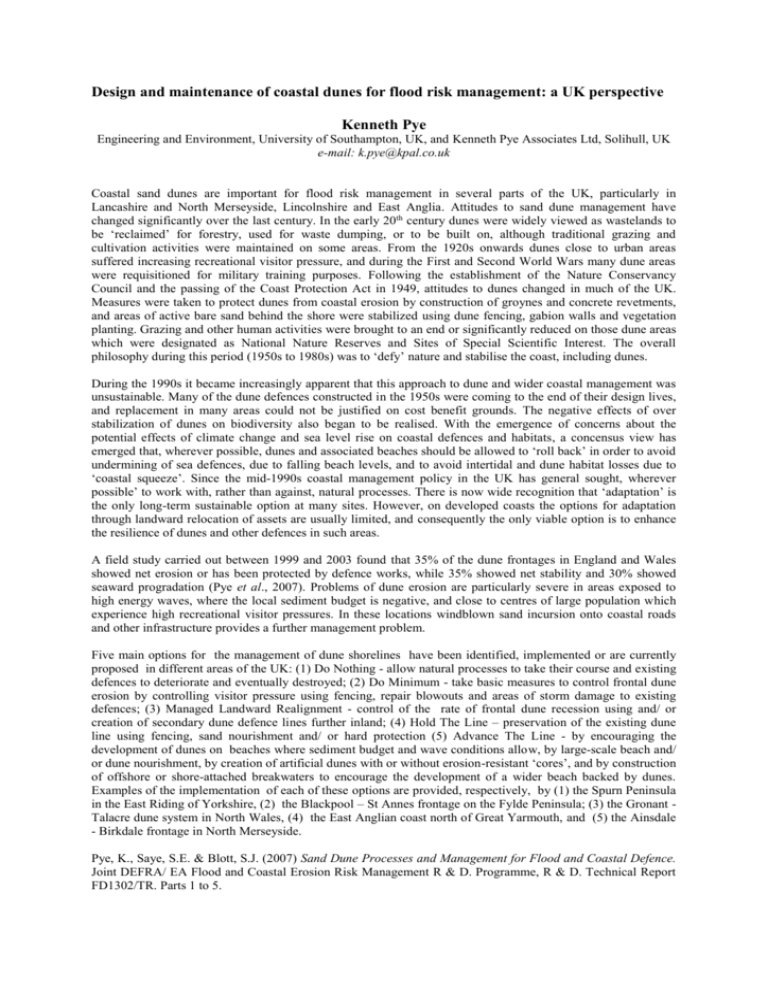
Design and maintenance of coastal dunes for flood risk management: a UK perspective Kenneth Pye Engineering and Environment, University of Southampton, UK, and Kenneth Pye Associates Ltd, Solihull, UK e-mail: k.pye@kpal.co.uk Coastal sand dunes are important for flood risk management in several parts of the UK, particularly in Lancashire and North Merseyside, Lincolnshire and East Anglia. Attitudes to sand dune management have changed significantly over the last century. In the early 20th century dunes were widely viewed as wastelands to be ‘reclaimed’ for forestry, used for waste dumping, or to be built on, although traditional grazing and cultivation activities were maintained on some areas. From the 1920s onwards dunes close to urban areas suffered increasing recreational visitor pressure, and during the First and Second World Wars many dune areas were requisitioned for military training purposes. Following the establishment of the Nature Conservancy Council and the passing of the Coast Protection Act in 1949, attitudes to dunes changed in much of the UK. Measures were taken to protect dunes from coastal erosion by construction of groynes and concrete revetments, and areas of active bare sand behind the shore were stabilized using dune fencing, gabion walls and vegetation planting. Grazing and other human activities were brought to an end or significantly reduced on those dune areas which were designated as National Nature Reserves and Sites of Special Scientific Interest. The overall philosophy during this period (1950s to 1980s) was to ‘defy’ nature and stabilise the coast, including dunes. During the 1990s it became increasingly apparent that this approach to dune and wider coastal management was unsustainable. Many of the dune defences constructed in the 1950s were coming to the end of their design lives, and replacement in many areas could not be justified on cost benefit grounds. The negative effects of over stabilization of dunes on biodiversity also began to be realised. With the emergence of concerns about the potential effects of climate change and sea level rise on coastal defences and habitats, a concensus view has emerged that, wherever possible, dunes and associated beaches should be allowed to ‘roll back’ in order to avoid undermining of sea defences, due to falling beach levels, and to avoid intertidal and dune habitat losses due to ‘coastal squeeze’. Since the mid-1990s coastal management policy in the UK has general sought, wherever possible’ to work with, rather than against, natural processes. There is now wide recognition that ‘adaptation’ is the only long-term sustainable option at many sites. However, on developed coasts the options for adaptation through landward relocation of assets are usually limited, and consequently the only viable option is to enhance the resilience of dunes and other defences in such areas. A field study carried out between 1999 and 2003 found that 35% of the dune frontages in England and Wales showed net erosion or has been protected by defence works, while 35% showed net stability and 30% showed seaward progradation (Pye et al., 2007). Problems of dune erosion are particularly severe in areas exposed to high energy waves, where the local sediment budget is negative, and close to centres of large population which experience high recreational visitor pressures. In these locations windblown sand incursion onto coastal roads and other infrastructure provides a further management problem. Five main options for the management of dune shorelines have been identified, implemented or are currently proposed in different areas of the UK: (1) Do Nothing - allow natural processes to take their course and existing defences to deteriorate and eventually destroyed; (2) Do Minimum - take basic measures to control frontal dune erosion by controlling visitor pressure using fencing, repair blowouts and areas of storm damage to existing defences; (3) Managed Landward Realignment - control of the rate of frontal dune recession using and/ or creation of secondary dune defence lines further inland; (4) Hold The Line – preservation of the existing dune line using fencing, sand nourishment and/ or hard protection (5) Advance The Line - by encouraging the development of dunes on beaches where sediment budget and wave conditions allow, by large-scale beach and/ or dune nourishment, by creation of artificial dunes with or without erosion-resistant ‘cores’, and by construction of offshore or shore-attached breakwaters to encourage the development of a wider beach backed by dunes. Examples of the implementation of each of these options are provided, respectively, by (1) the Spurn Peninsula in the East Riding of Yorkshire, (2) the Blackpool – St Annes frontage on the Fylde Peninsula; (3) the Gronant Talacre dune system in North Wales, (4) the East Anglian coast north of Great Yarmouth, and (5) the Ainsdale - Birkdale frontage in North Merseyside. Pye, K., Saye, S.E. & Blott, S.J. (2007) Sand Dune Processes and Management for Flood and Coastal Defence. Joint DEFRA/ EA Flood and Coastal Erosion Risk Management R & D. Programme, R & D. Technical Report FD1302/TR. Parts 1 to 5.


